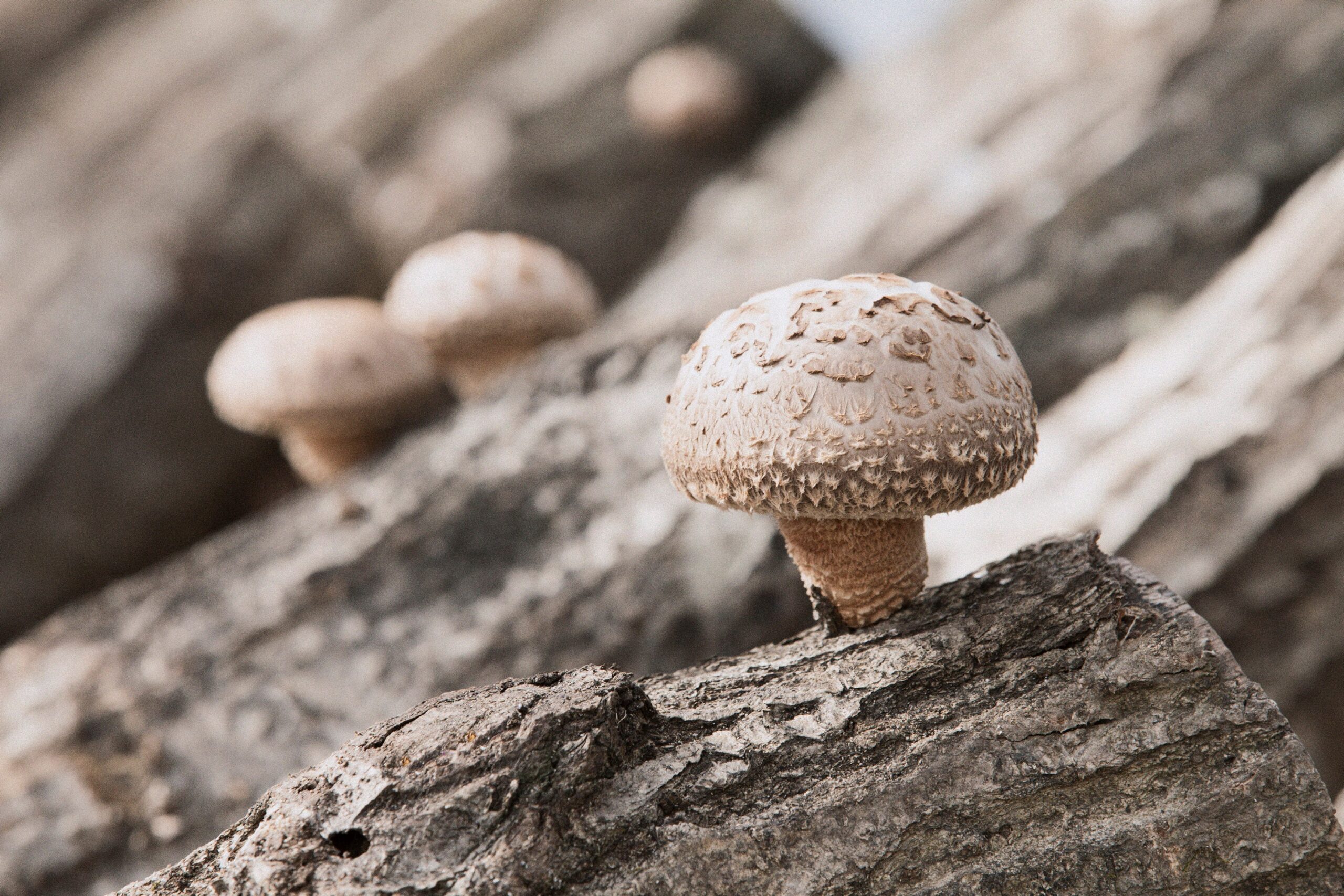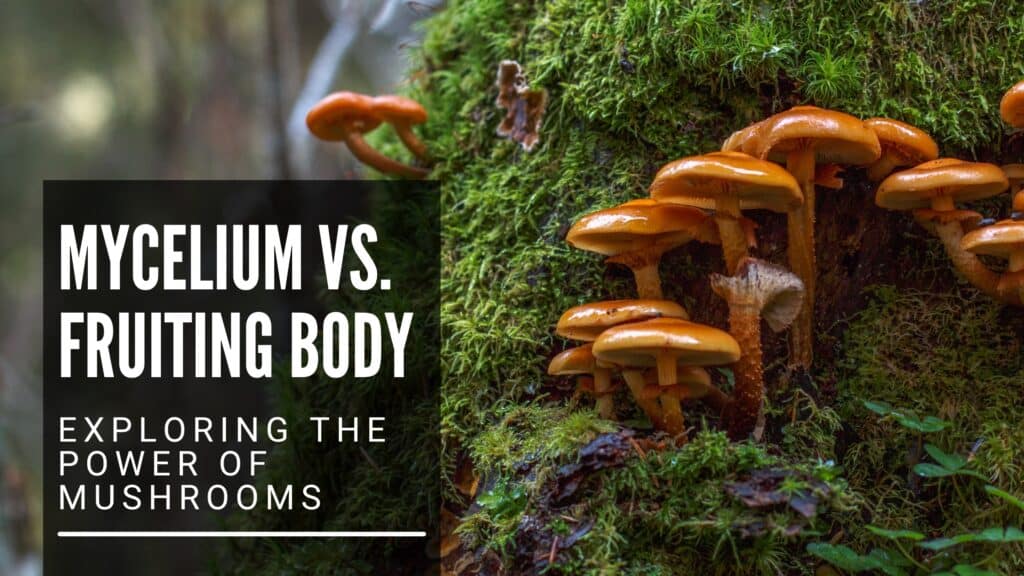Mushrooms are increasingly recognized for their health benefits, making them a popular choice among superfoods. This article explores the distinct parts of the mushroom: the mycelium and the fruiting body. Each plays a critical role in the mushroom’s lifecycle and offers unique health benefits.
Quick Summary:
- Mycelium: The underground network that absorbs nutrients, supports the fruiting body, and plays a crucial role in ecosystem health.
- Fruiting Body: The above-ground part that contains a concentration of nutrients like proteins, vitamins, and minerals.
- Health Benefits: Both mycelium and fruiting body contribute to immune support, cognitive health, and overall wellness.
- Choosing Supplements: Importance of selecting products that utilize the entire mushroom lifecycle for maximum health benefits.

What is Mycelium?
Mycelium is the vegetative part of a fungus, consisting of a network of fine, thread-like structures known as hyphae. It forms an extensive underground lattice that permeates the soil or substrate in which it grows. Unlike the fruiting body, which is the reproductive part visible above ground, the mycelium works behind the scenes, playing a crucial role in the mushroom’s growth and the ecosystem’s nutrient cycle.
Structure and Function
The mycelium’s primary function is to absorb nutrients from its environment, which it does through its expansive and intricate network. This network allows the fungus to consume organic material by excreting enzymes that break down complex molecules into simpler compounds that can be absorbed. The mycelium is capable of rapid growth under the right conditions, spreading out extensively to maximize contact with nutrient sources.
Hyphae, the building blocks of mycelium, are tiny tubes filled with cytoplasm and nuclei. These hyphae branch and fuse in a web-like manner, creating a complex and dynamic organism that can adapt to and colonize new environments quickly. This adaptability is partly why fungi are found in almost every habitat on Earth, from deep forests to urban settings.
Bioactive Compounds and Health Benefits
Mycelium is a rich source of bioactive compounds, which include enzymes, antibiotics, and acids. These compounds can defend the fungus from pathogens and predators, and many have been found to have health benefits for humans, including anti-inflammatory, antioxidant, and immune-modulating effects. Research has demonstrated that certain species of mycelium produce specific compounds that can support human health in unique ways, such as lowering cholesterol levels or enhancing immune response.
Mycelium in Biotechnology and Medicine
Beyond its ecological and health contributions, mycelium has exciting applications in biotechnology. It is being explored for its potential in bioremediation, as it can break down pollutants like pesticides, plastics, and heavy metals. Mycelium is also at the forefront of developing sustainable materials, including biodegradable packaging and building materials that offer an eco-friendly alternative to synthetic products.

What is the Fruiting Body?
The fruiting body, commonly recognized as the mushroom itself, is the reproductive structure that emerges from the mycelium, the vegetative part of the fungus. Unlike the mycelium, which operates largely unseen within the substrate, the fruiting body is visible above the ground and plays a critical role in the mushroom’s life cycle, especially in spore dissemination.
Structure and Composition
Fruiting bodies vary widely in shape, size, and color, but they typically consist of several key components: the cap, the stipe (stem), gills or pores underneath the cap, and often a veil protecting the reproductive parts. These structures are rich in a variety of bioactive compounds, including polysaccharides, vitamins, and minerals, which differ markedly from those found in the mycelium.
The cell walls of the fruiting body are primarily composed of chitin, a tough natural polymer that helps the mushroom maintain its structure and protect itself from environmental stresses. This chitin content makes the fruiting body denser and less permeable than the mycelium, affecting both its texture and the bioavailability of its nutrients.
Nutritional and Medicinal Value
The fruiting body is renowned for its nutritional value, offering a high concentration of protein, fiber, and essential minerals like potassium, selenium, zinc, and magnesium. It is also a source of B vitamins, which are crucial for energy metabolism and brain health. Beyond their basic nutritional content, fruiting bodies are valued for their medicinal properties. They contain a range of antioxidants and anti-inflammatory agents that can support immune health, reduce the risk of chronic diseases, and provide anti-aging benefits.
Polysaccharides, such as beta-glucans found in the cell walls of the fruiting bodies, are particularly noted for their ability to modulate the immune system. These compounds can activate immune cells like macrophages and natural killer cells, enhancing the body’s defense mechanisms against pathogens and tumors.
Comparative Analysis: Mycelium vs. Fruiting Body
In understanding the roles and benefits of mycelium and fruiting bodies, it’s essential to delve into their distinct biological functions, nutritional profiles, and their unique contributions to health and medicine. This comparative analysis will highlight the differences and synergies between these two fundamental components of fungi.
Biological Functions and Structure
Mycelium serves as the foundational network of the fungus, largely unseen and spread throughout the substrate. It is primarily responsible for nutrient absorption and growth, breaking down organic materials in the environment. This vast network facilitates not only the survival and expansion of the fungus but also plays a critical role in the ecosystem by decomposing material and cycling nutrients.
Fruiting Body, on the other hand, is the above-ground part of the mushroom that most people recognize. It emerges from the mycelium when environmental conditions are right, primarily functioning as the reproductive structure of the fungus. It produces spores, which are dispersed to give rise to new fungal colonies.
Nutritional Content and Health Benefits
Mycelium is rich in enzymes and other bioactive molecules that can promote health. Studies have shown that mycelium contains compounds that support the immune system, reduce inflammation, and can even have antiviral properties. For example, the mycelium of the turkey tail mushroom has been studied for its potential in cancer therapy due to its high content of polysaccharopeptide, which can boost the immune system and help fight cancer cells.
Fruiting bodies are typically richer in dietary fibers, vitamins, and minerals necessary for human health. They contain high levels of antioxidants like ergothioneine and selenium, which help reduce oxidative stress and may lower the risk of chronic diseases. The beta-glucans in mushroom caps and stems are especially noted for their immune-modulating effects.
Applications in Supplements and Therapeutics
Supplements may utilize either part of the mushroom or both, depending on the desired health effects. Mycelium is often used in products targeting immune support and stress reduction, as its bioactive compounds are effective in modulating body systems. It’s commonly found in powdered form or as an ingredient in complex health supplements.
Fruiting bodies are frequently used in extracts and powders focused on enhancing nutrition and providing high levels of specific compounds like antioxidants and vitamins. They are popular in culinary uses due to their texture and flavor, which are not only enjoyable but also provide health benefits.
Mushroom Products: What to Look For
When choosing mushroom supplements, it’s essential to consider products that utilize the entire lifecycle of the mushroom. Look for:
- Full-Spectrum Products: These contain both mycelium and fruiting bodies, ensuring a wide range of nutrients and bioactive compounds.
- Certifications: Products should be certified for quality and safety, indicating they are free from contaminants.
- Bioavailability: Supplements should be processed in a way that makes their nutrients easily absorbable.
Conclusion
The exploration of mycelium and fruiting bodies reveals the vast potential of mushrooms, not only as a health supplement but also as an essential part of ecological sustainability. Each component of the mushroom—mycelium and fruiting body—offers unique and complementary health benefits that make mushrooms a versatile superfood. The mycelium provides vital bioactive compounds that support immune health and environmental balance, while the fruiting bodies deliver dense nutrients and antioxidants critical for overall well-being.
Understanding these components empowers consumers to make informed choices about mushroom supplements, ensuring they select products that align with their health goals. By appreciating the full lifecycle of mushrooms, one gains insight into the holistic benefits these organisms offer. Whether for dietary supplementation, culinary enjoyment, or ecological preservation, mushrooms play a pivotal role in promoting a healthier world.
As research continues to uncover the profound benefits of both mycelium and fruiting bodies, it becomes clear that integrating mushrooms into our diets and medical practices can significantly enhance human health and environmental resilience. We are encouraged to embrace the diverse applications of mushrooms and explore the myriad ways they can enrich our lives and ecosystems.
References:
- Chen, Wan-Jing, and Fung-Wei Chang. “A Pilot Study to Assess Food Safety and Potential Cholesterol-Lowering Efficacy of Antrodia Cinnamomea Solid-State Cultivated Mycelium in Healthy Adults.” Evidence-Based Complementary and Alternative Medicine, vol. 2020, 9 Apr. 2020, pp. 1–6, https://doi.org/10.1155/2020/5865764. Accessed 12 Sept. 2022.
- Kraft, Stephanie, et al. “Mold, Mycotoxins and a Dysregulated Immune System: A Combination of Concern?” International Journal of Molecular Sciences, vol. 22, no. 22, 12 Nov. 2021, p. 12269, www.ncbi.nlm.nih.gov/pmc/articles/PMC8619365/, https://doi.org/10.3390/ijms222212269. Accessed 3 Jan. 2022.
- Lin, Liang-Hung, et al. “Immunomodulatory Effects of Fruiting Body Extract and Solid-State-Cultivated Mycelia of Taiwanofungus Camphoratus.” Nutrients, vol. 11, no. 9, 19 Sept. 2019, p. 2256, https://doi.org/10.3390/nu11092256. Accessed 31 Oct. 2019.
- Murphy, E Angela, et al. “Immune Modulating Effects of β-Glucan.” Current Opinion in Clinical Nutrition and Metabolic Care, vol. 13, no. 6, Nov. 2010, pp. 656–661, https://doi.org/10.1097/mco.0b013e32833f1afb.
- “Turkey Tail Mushrooms: Immune System, Cancer, and More.” Www.medicalnewstoday.com, 25 Mar. 2020, www.medicalnewstoday.com/articles/turkey-tail-mushroom#:~:text=Turkey%20tail%20mushrooms%20contain%20compounds. Accessed 16 May 2024.

